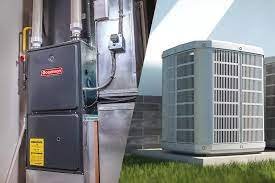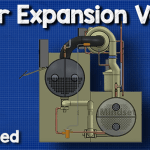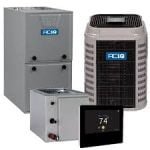HSPF4 vs HSPF5: Heat pumps are excellent devices that can keep your home or business warm in winter and cool in summer. Their main function is to transfer heat from one place to another. However, how do you know how effective your heat pump is and how much it consumes? One way to determine this is by looking at the HSPF rating of your heat pump. It indicates how much heat your heat pump can produce for every unit of electricity it uses. A higher HSPF means a more efficient heat pump.
HSPF (Heating Seasonal Performance Factor) is vital in selecting the best heat pump for your system. HSPF4 and HSPF5 are ratings based on different climate zones and test conditions that can impact your system performance and cost. We’ll explain what they are, how they’re calculated, and why they’re essential. Based on these ratings, we’ll also give you tips for choosing the best heat pump.
What is HSPF, and How is it Calculated?
HSPF is the ratio of the total heating output of a heat pump over a heating season divided by the total electricity input during the same period. In other words, it tells you how much heat a heat pump can produce for every unit of electricity it consumes. A higher HSPF means a more efficient heat pump.
HSPF is calculated by using a formula that takes into account the following factors:
- The heating output of the heat pump at different outdoor temperatures ranges from 17°F to 62°F.
- The electricity input of the heat pump at different outdoor temperatures, including the power consumption of the compressor, the fan, the defrost cycle, and the backup heating.
- The number of hours the heat pump operates at each outdoor temperature is based on the average weather data for a specific climate zone.
- The coefficient of performance (COP) of the heat pump is the ratio of the heating output to the electricity input at a given outdoor temperature.
The formula for calculating HSPF is:
HSPF = (Total heating output at all outdoor temperatures) / (Total electricity input at all outdoor temperatures)
The unit of HSPF is Btu/W·h, which means British thermal units per watt-hour.
Understanding HSPF4 vs HSPF5 Factors
| Aspect | HSPF4 | HSPF5 |
| Climate Zone Coverage | Covers Climate Zone 4 (e.g., Florida, Texas, California) | Covers Climate Zone 5 (e.g., New York, Illinois, Minnesota) |
| Average Temperature (°F) | Around 47°F | Around 35°F |
| Humidity Level | 50% | 45% |
| Test Conditions Standard | ANSI/AHRI Standard 210/240 (2006 version) | ANSI/AHRI Standard 210/240 (updated 2017 version) |
| Usage Recommendations | Ideal for southern states with milder winters | Suitable for northern states with colder climates and higher heating demands |
| Key Considerations for Selection | Check EnergyGuide label for accurate comparison | Consider your specific climate zone and heating requirements |
| Standard Version for Rating | 2006 ANSI/AHRI Standard 210/240 | Updated ANSI/AHRI Standard 210/240 |
| Certifications to Look For | ENERGY STAR label for adherence to DOE standards | ENERGY STAR label ensures high quality and performance |
HSPF4 vs HSPF5 – Why Are They Essential?
HSPF4 and HSPF5 are essential because they can affect the way you compare and choose a heat pump for your needs. Depending on the climate zone you live in and the version of the standard you use, you may get different HSPF ratings for the same heat pump. This can make evaluating the efficiency and performance of other heat pump models confusing and misleading.
Don’t forget to learn about SEER Vs AFUE In Energy-Efficient Heating And Cooling.
For instance, The average HSPF4 rating for a split-system heat pump is 8.8, while the average HSPF5 rating is 7.5. This means the same heat pump can have a 15% lower HSPF rating when measured in Climate Zone 5 than in Climate Zone 4. This does not mean that the heat pump is less efficient in Climate Zone 5, but rather that it has to work harder to provide heating in a colder and drier climate.
What is the Difference Between HSPF4 and HSPF5?
HSPF can be measured by two methods, HSPF4 and HSPF5, which vary based on different climate zones and test conditions. The US Department of Energy defines climate zones based on other regions’ average outdoor temperature and humidity levels. Test conditions simulate heating performance under different scenarios, such as indoor/outdoor temperatures, airflow rate, defrost cycle, and backup heating.
HSPF4 vs HSPF5 – Region Comperison
HSPF4 is a rating that measures the performance of heat pumps in Climate Zone 4, covering southern states such as Florida, Texas, and California. The average temperature in this zone is around 47°F, with a humidity level of 50%. The test conditions used to measure HSPF4 are based on the 2006 version of the ANSI/AHRI Standard 210/240, the industry standard for testing and rating heat pumps.
HSPF5 is a rating that measures the performance of heat pumps in Climate Zone 5, covering northern states such as New York, Illinois, and Minnesota. The average temperature in this zone is around 35°F, with a humidity level of 45%. The test conditions used to measure HSPF5 are based on the updated version of the ANSI/AHRI Standard 210/240, the industry standard for testing and rating heat pumps.
How do you compare and choose the best heat pump based on HSPF4 and HSPF5?
Here are some tips for comparing and selecting the best heat pump based on its heating season performance factor (HSPF).
Check the EnergyGuide: The label displays the HSPF rating, estimated annual energy cost, and model comparison. It also specifies the climate zone and standard version used to calculate the HSPF rating. You can use this information to compare the efficiency and performance of various heat pump models.
Use the climate zone HSPF rating: To select the most appropriate heat pump for your heating requirements, it is crucial to use the proper HSPF rating. If you reside in Climate Zone 4, you should use the HSPF4 rating, whereas, for Climate Zone 5, the HSPF5 rating is recommended. This approach will ensure that you have access to the most accurate and realistic HSPF rating for your heating needs.
Don’t forget to learn about SEER Vs AFUE In Energy-Efficient Heating And Cooling.
Use the latest version of the HSPF rating: For accurate results, use the 2017 ANSI/AHRI Standard 210/240 for the HSPF rating. It is the most comprehensive and reliable method to test and rate heat pumps.
Look for the ENERGY STAR label on the heat pump: The label on the heat pump indicates it meets or exceeds the minimum HSPF and SEER ratings set by the DOE for your climate zone. ENERGY STAR certification guarantees third-party testing for high quality and performance.
Conclusion
HSPF4 and HSPF5 are two different ratings that measure the heating efficiency of heat pumps based on different climate zones and test conditions. The difference between HSPF4 and HSPF5 can affect the way you compare and choose a heat pump for your needs, as it can give you different HSPF ratings for the same heat pump. Therefore, you should pay attention to the HSPF rating that is relevant to your climate zone and the version of the standard used, and look for other factors that can influence the efficiency and performance of your heat pump. Contact us for more help or advice on HSPF4 vs HSPF5.
Frequently asked Questions(FAQs)
How do you convert HSPF region 4 to 5?
If the HSPF rating does not clearly state that it is for climate region 5, the HSPF number is most likely for climate region 4. Divide the Region 4 HSPF value by 1.15 to get the Region 5 HSPF value.
What is HSPF Region 5?
The heating seasonal performance factor (HSPF) of market available units can range from 7.1 to 13.2 (Region 5) on a seasonal basis. It is crucial to remember that these HSPF estimations are for a climate similar to that of Ottawa. Actual savings depend on where your heat pump is installed.
What is the best HSPF rating?
The best HSPF rating is determined by the climate zone. A higher HSPF is preferable for colder climates in Region 5 to improve heating efficiency. Ratings of 9.6 HSPF or above are effective, especially in Zones 6 and 8, which have cooler temperatures.
What is the HSPF for cold climates?
Cold environment heat pumps can have an HSPF of 10 or more, transferring much more energy than they consume. During the summer, heat pumps switch to cooling mode and perform as well (or better) as brand-new air conditioning units.





